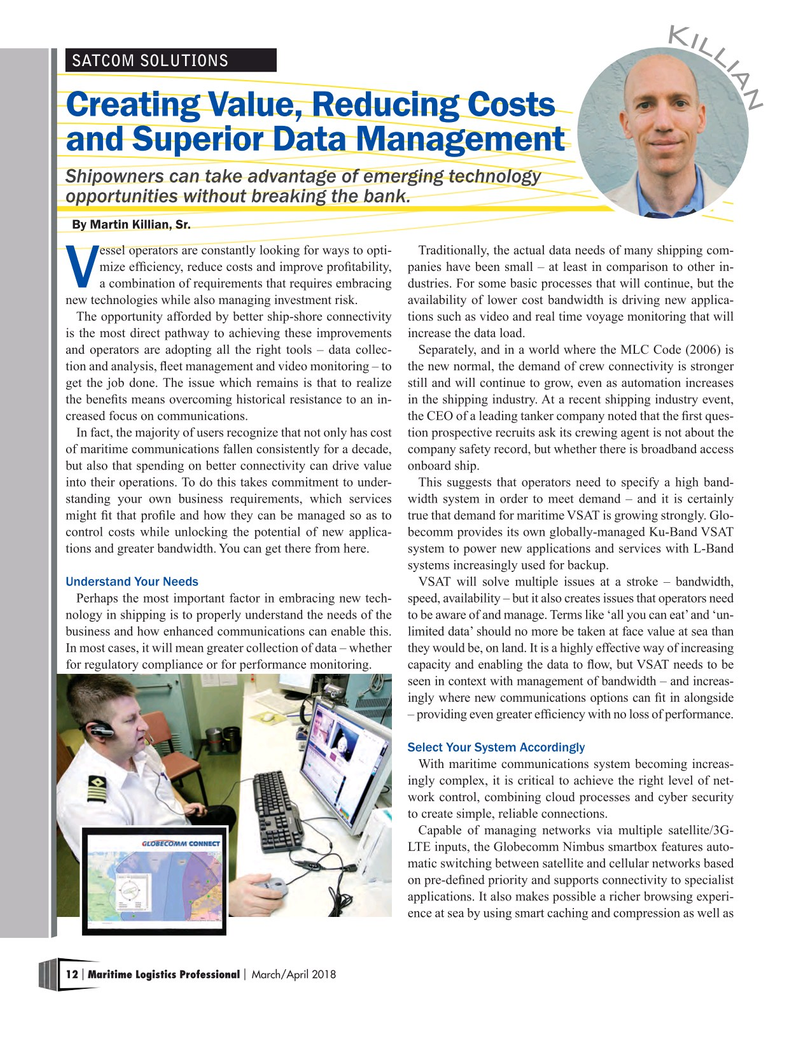
Page 12: of Maritime Logistics Professional Magazine (Mar/Apr 2018)
IT & Software
Read this page in Pdf, Flash or Html5 edition of Mar/Apr 2018 Maritime Logistics Professional Magazine
K i l l
SATCOM SOLUTIONS i a n
Creating Value, Reducing Costs and Superior Data Management
Shipowners can take advantage of emerging technology opportunities without breaking the bank.
By Martin Killian, Sr.
essel operators are constantly looking for ways to opti- Traditionally, the actual data needs of many shipping com- mize effciency, reduce costs and improve proftability, panies have been small – at least in comparison to other in-
Va combination of requirements that requires embracing dustries. For some basic processes that will continue, but the new technologies while also managing investment risk. availability of lower cost bandwidth is driving new applica-
The opportunity afforded by better ship-shore connectivity tions such as video and real time voyage monitoring that will is the most direct pathway to achieving these improvements increase the data load.
and operators are adopting all the right tools – data collec- Separately, and in a world where the MLC Code (2006) is tion and analysis, feet management and video monitoring – to the new normal, the demand of crew connectivity is stronger get the job done. The issue which remains is that to realize still and will continue to grow, even as automation increases the benefts means overcoming historical resistance to an in- in the shipping industry. At a recent shipping industry event, creased focus on communications. the CEO of a leading tanker company noted that the frst ques-
In fact, the majority of users recognize that not only has cost tion prospective recruits ask its crewing agent is not about the of maritime communications fallen consistently for a decade, company safety record, but whether there is broadband access but also that spending on better connectivity can drive value onboard ship.
into their operations. To do this takes commitment to under- This suggests that operators need to specify a high band- standing your own business requirements, which services width system in order to meet demand – and it is certainly might ft that profle and how they can be managed so as to true that demand for maritime VSAT is growing strongly. Glo- control costs while unlocking the potential of new applica- becomm provides its own globally-managed Ku-Band VSAT tions and greater bandwidth. You can get there from here. system to power new applications and services with L-Band systems increasingly used for backup.
Understand Your Needs VSAT will solve multiple issues at a stroke – bandwidth,
Perhaps the most important factor in embracing new tech- speed, availability – but it also creates issues that operators need nology in shipping is to properly understand the needs of the to be aware of and manage. Terms like ‘all you can eat’ and ‘un- business and how enhanced communications can enable this. limited data’ should no more be taken at face value at sea than
In most cases, it will mean greater collection of data – whether they would be, on land. It is a highly effective way of increasing for regulatory compliance or for performance monitoring. capacity and enabling the data to fow, but VSAT needs to be seen in context with management of bandwidth – and increas- ingly where new communications options can ft in alongside – providing even greater effciency with no loss of performance.
Select Your System Accordingly
With maritime communications system becoming increas- ingly complex, it is critical to achieve the right level of net- work control, combining cloud processes and cyber security to create simple, reliable connections.
Capable of managing networks via multiple satellite/3G-
LTE inputs, the Globecomm Nimbus smartbox features auto- matic switching between satellite and cellular networks based on pre-defned priority and supports connectivity to specialist applications. It also makes possible a richer browsing experi- ence at sea by using smart caching and compression as well as 12 Maritime Logistics Professional March/April 2018 | |

 11
11

 13
13
